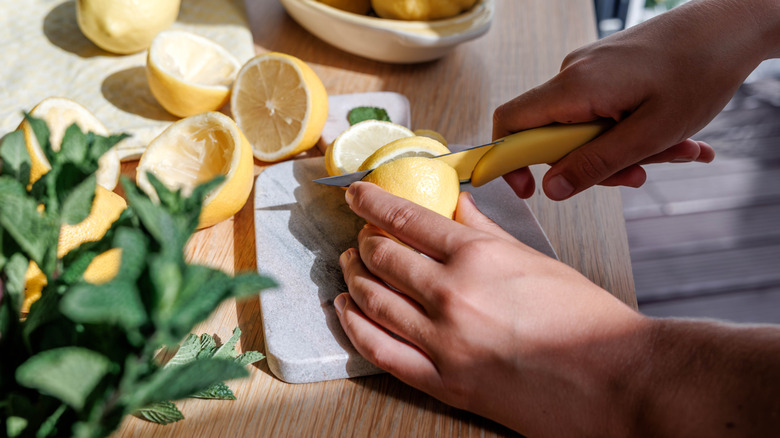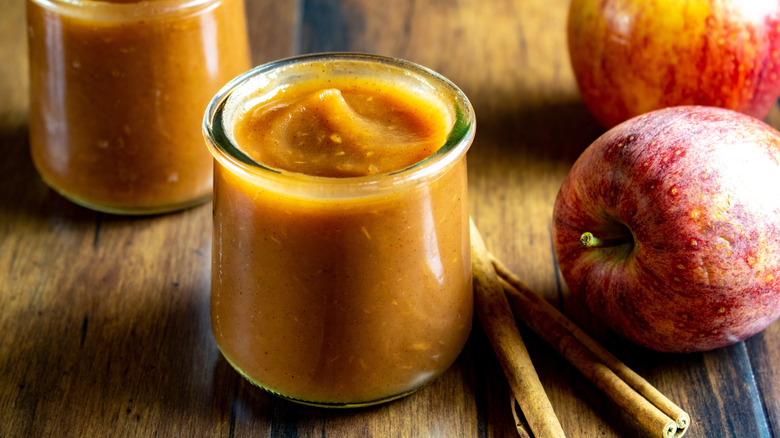Don't Toss Leftover Lemons When You Could Make A Comforting Treat Instead
Even if life gives you lemons by the bushel, there's no reason you should ever have to throw them out. There's so much you can do with this most versatile of fruits — of course, you can make lemonade, it's traditional with fish, and lemon juice can even be used to flavor popcorn. Even if you're in full fall flavor mode, lemon juice is still a star ingredient. It's well-known to work wonders in apple pie, and YES! Apple's culinary consultant, Caroline Fey, says it can do the same for apple butter.
"Lemon juice is traditionally used in making apple butter because it helps to brighten the flavors of the butter and balance the sweetness. Especially if you are using sweeter, less tart apples to make the apple butter," Fey said. She noted that lemon juice is usually added at the end, when tasting the finished product and adjusting the flavor.
Apple butter is usually made only with tart lemon juice, not the slightly bitter zest. As Fey explained, "If you decide to add the zest to the apple butter, it will have a much more pronounced lemon flavor, which can clash with some of the baking spices that are traditionally used in making the butter." This doesn't mean it can't be done, but if you do choose to use lemon zest, her advice is to omit any cinnamon, nutmeg, and cloves from the recipe and replace them with citrus-friendly spices such as allspice, cardamom, and ginger.
How to make lemony apple butter
Caroline Fey shared some of her apple expert tips for making apple butter when prepping the apples. Once they are sliced, she advised, "Sprinkle the apples with a little bit of the lemon juice to prevent browning."
Put the apples in a pot with sugar, spices, and a tiny bit of salt. (The zest, if used, also goes in at this point.) Cover the pot and simmer the apple mixture over medium-low heat for about an hour, stirring occasionally to prevent the apples from sticking or scorching. When they're soft, they'll need to be pureed. If you have an immersion blender, you can use it right in the pot, but if you plan to transfer the apples to a food processor or blender, let them cool first.
Simmer the pureed apples for about two hours, leaving the pot uncovered this time. The apple butter is done when it's so thick that a spoonful scooped out onto a plate holds its shape without collapsing. Remove from the heat and stir in the lemon juice to taste. Let it cool, then put it into clean jars. According to Fey, "It can be stored in the refrigerator for up to a month, or it can be traditionally canned for shelf stability."
Apple butter isn't just for toast
Apple butter is delicious on toast or biscuits, and it goes great with pancakes as well (either as a substitute for or in addition to maple syrup). For a double dose of fall flavor, you can spread it on apple or pumpkin quick bread. Apple butter also has savory applications, such as a secret ingredient in barbecue sauce. If you've made it extra-lemony, this will provide both the sour notes and sweetness that a well-balanced barbecue sauce needs.
Caroline Fey says that lemony apple butter can be used in a wide variety of dishes. Among her suggestions for sweet options are lemon-ginger apple pie bars with a candied ginger crumble and apple swirl muffins with a lemon streusel topping. For something savory, she suggests using it in an apple and whole-grain mustard glaze for roasted salmon or mixing it with white wine, Dijon mustard, garlic, shallots, and chicken stock to make a sauce for pork tenderloin. Apple butter can even serve as the base for a vinaigrette or a topping for vegetables like cabbage.


